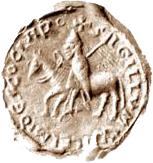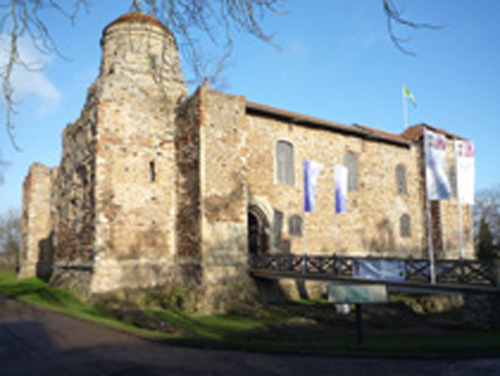Hamo de Saint Clair
Hamo de Saint Clair was the most significant of the two Anglo-Norman Saint Clair brothers, the other being William. His date of birth is not known, but based on the earliest known royal charter he witnessed it seems that it was c.1099. If his father was Hubert, it is likely that he and his brothers were still minors when he died and were brought up in the household of Gilbert de Vilers and their mother.
After Eudo de Rie (the sewar or steward) died in 1120 and his lands escheated, Henry I granted Hamo a number of manors previously held by Eudo. The most important were Eaton Socon in Bedfordshire and Walkern in Hertfordshire, but others included Lexden in Essex, Abbotsbury and the manor of the Rectory of Barkway in Hertfordshire, Chalk in Kent, Wakerley in Northamptonshire, Sandy in Bedfordshire and Ashe in Hampshire, as well as Kingstone in Somerset, his inheritance from Hubert.
At Domesday, Eaton Socon was Eudo’s principal manor, amounting to 20 hides (about 2400 acres) and including two mills, 100 eels, woodland for 400 swine, and 2 acres of vineyard. Hamo’s holdings in Bedfordshire alone totalled 44 hides (5280 acres) in 1129. Walkern was smaller at 10 hides (1200 acres), based on the Domesday survey in 1086. At that time Eudo did not hold Walkern, so must have received it from William Rufus or Henry I prior to his death in 1120.
In 1127, Hamo became the sheriff of Essex, and in 1128-30 he was the bailiff of Colchester. His first marriage was to Gunnor, a daughter of the powerful Bigod family in East Anglia. His second marriage was to Margaret, the daughter of Robert FitzWalter of Horsford, the sheriff of Norfolk. Her half brother, William de Caisneto, also became the sheriff of Norfolk, which suggests that Hamon’s marriage and becoming the sheriff of Essex were closely related.
Hamo and his brother William became important benefactors of St. John’s Abbey in Colchester, founded by Eudo dapifer in 1097, many of their charters confirming Eudo’s previous donations. Hamo’s wife, Margaret, also donated her magitarium of Stokes manor to St. John’s, which may have been Stoke by Clare or Stoke by Nayland, both recorded in the Abbey’s records at its dissolution.
Hubert de Saint Clair was Hamo and Gunnor’s only child. Hubert married Clemence, who was most likely a daughter of the de Clare family at Weston, a manor neighbouring Walkern. After Hubert died, Clemence remained living at the de Clare manor of Newberry, her maritagium, until her death at 80 years of age in 1205.
Henry I died in 1134 and when Stephen succeeded, Hamo continued serving the crown and benefiting from his holdings and the financially profitable ‘fee-farm’ of Colchester. He was a witness to king Stephen’s Charter of Liberties, issued at Oxford, Easter 1136, as well as other charters. He died c.1155 and Hubert inherited his many estates, including Hamerton in Huntingdonshire since William, Hamo’s brother, had died c.1149. However, Eaton Socon and Hamo’s Bedfordshire holdings passed to Hugh de Beauchamp, probably as a reward from Henry II for services rendered by Hugh before he was crowned in 1154.
In 1155, soon after the death of his father, Hubert, who had taken over from his father as the constable of Colchester, was killed at Bridgnorth in Shropshire when he bravely stepped between the king, and an assailant during a siege of Hugh de Mortimer’s castle. Henry arranged the marriage of Hubert’s only daughter, Gunnore, then a minor, to William de Lanvalei, one of his new men.



